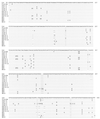Intervening transcribed spacer region 1 variability in Cyclospora cayetanensis
- PMID: 10834999
- PMCID: PMC86797
- DOI: 10.1128/JCM.38.6.2339-2343.2000
Intervening transcribed spacer region 1 variability in Cyclospora cayetanensis
Abstract
Cyclospora cayetanensis is an apicomplexan protozoan parasite which has emerged as an important cause of epidemic and endemic diarrhea. Water-borne as well as food-borne outbreaks have occurred, including a large number of U.S. cases associated with raspberries imported from Guatemala. Molecular markers exist for tracing the epidemiology of many of the bacterial pathogens associated with water-borne or food-borne diarrhea, such as serotyping and pulsed-field electrophoresis. However, there are currently no molecular markers available for C. cayetanensis. The intervening transcribed spacer (ITS) regions between the small- and large-subunit rRNA genes demonstrate much greater sequence variability than the small-subunit rRNA sequence itself and have been useful for the molecular typing of other organisms. Thus, ITS1 variability might allow the identification of different genotypes of C. cayetanensis. In order to determine the degree of ITS1 variability among C. cayetanensis isolates, the ITS1 sequences of C. cayetanensis isolates from a variety of sources, including raspberry-associated cases, cases from Guatemala, and pooled and individual isolates from Peru, were obtained. The ITS1 sequences of all five raspberry-associated isolates were identical, consistent with their origin from a single source. In contrast, one of the two Guatemala isolates and two Peruvian isolates contained multiple ITS1 sequences. These multiple sequences could represent multiple clones from a single clinical source or, more likely, variability of the ITS1 region within the genome of a single clone.
Figures


References
-
- Arrowood M J, Sterling C R. Isolation of Cryptosporidium oocysts and sporozoites using discontinuous sucrose and isopycnic Percoll gradients. J Parasitol. 1987;73:314–319. - PubMed
-
- Ashford R W. Occurrence of an undescribed coccidian in man in Papua New Guinea. Ann Trop Med Parasitol. 1979;73:497–500. - PubMed
-
- Bendall R P, Lucas S, Moody A, Tovey G, Chiodini P L. Diarrhoea associated with cyanobacterium-like bodies: a new coccidian enteritis of man. Lancet. 1993;341:590–592. - PubMed
-
- Dalrymple B P. Cloning and characterization of the rRNA genes and flanking regions from Babesia bovis: use of the genes as strain discriminating probes. Mol Biochem Parasitol. 1990;43:117–124. - PubMed
-
- Gunderson J H, Sogin M L, Wollett G, Hollingdale M, de la Cruz V, Waters A P, McCutchan T F. Structurally distinct, stage-specific ribosomes occur in Plasmodium. Science. 1987;238:933–937. - PubMed
Publication types
MeSH terms
Substances
Grants and funding
LinkOut - more resources
Full Text Sources

